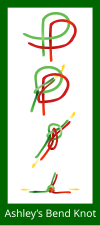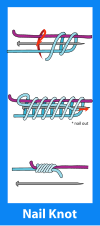Best Knot to Tie Two Ropes Together
knots used to join two lengths of rope
This is a list of bends. A bend is a knot used to join two lengths of rope.
The sheet bend is the classic bend. A study of 8 different bends using climbing rope found that the butterfly bend was strongest.[1]
Misuse of reef knot as a bend [edit]
The common reef knot (square knot) is sometimes mistakenly tied as a bend. When used as a bend rather than a binding knot, the reef knot will capsize under sufficient tension.[2] For this reason, the reef knot is insecure as a bend and as such is not listed as one.
Employed as a binding knot, to reef and furl sails or to tie up parcels, [the reef knot] is invaluable. But employed as a bend [...], the reef knot is probably responsible for more deaths and injuries than have been caused by the failure of all other knots combined.
Types of bends [edit]
| Knot | Description | Image |
|---|---|---|
| Adjustable bend | A bend that can be easily lengthened or shortened. | |
| Albright special | A low-profile bend suitable for monofilament or small-stuff. Mainly used in angling. |  |
| Ashley's bend | An original bend by Clifford Ashley consisting of interlocking overhand loops. |  |
| Beer knot | A bend suitable for tubular webbing. Its most common application is in slings used in rock climbing. |  |
| Blood knot | A low-profile bend most usefully employed for joining sections of monofilament nylon line while maintaining a high portion of the line's inherent strength. |  |
| Butterfly bend (Alpine butterfly bend) | A bend analogue of the butterfly loop. |  |
| Carrick bend | A bend that is particularly appropriate for very heavy rope or cable that is too large and stiff to be easily formed into other common bends. |  |
| Fisherman's knot Double fisherman's knot Triple fisherman's knot | A symmetrical bend tied with two overhand knots around the standing end of the other line. A variation of the fisherman's knot consisting of two double overhands. A variation of the fisherman's knot consisting of triple overhands. |  |
| Flemish bend | A bend based on the figure-eight knot. |  |
| Harness bend | A bend that can be pulled taut before securing. |  |
| Heaving line bend | A bend suitable for tying smaller lines to larger lines, such as in attaching playing strings to the thick silk eyes of the anchorage knot. |  |
| Hunter's bend | A bend consisting of two interlocking overhand knots. |  |
| Nail knot | A bend used in fly fishing to join lines of different diameters. It is useful but difficult to tie by hand. |  |
| One-sided overhand bend | A bend formed by tying a single overhand knot in two lines facing the same direction. |  |
| Racking bend | A bend for joining lines of different diameters. It is more secure than the heaving line bend or sheet bend due to the woven figure-eight knot "rackings". |  |
| Reever Knot | A secure and compact bend. |  |
| Sheet bend | A common bend for joining lines of different diameters. |  |
| Shroud knot | A multi-strand bend used to join two ends of laid (or twisted) rope together. |  |
| Simple Simon under |  | |
| Single carrick bend | | |
| Surgeon's knot | A bend commonly employed in small-stuff. It can be pulled taut before securing. | |
| True lover's knot | A bend consisting of interlocking overhand knots. |  |
| Water knot | A bend suitable for flat material such as leather or webbing. |  |
| Zeppelin bend | A bend consisting of interlocking overhand knots. It is similar to the hunter's bend but offers advantages in that it is jam resistant and easy to untie. |  |
See also [edit]
- List of knot terminology
- Binding knot
- Rope splicing
- Whipping knot
References [edit]
- ^ Knot Break Strength vs Rope Break Strength
- ^ Ashley, Clifford W. (1944). The Ashley Book of Knots. Doubleday. pp. 9, 18.
Bibliography [edit]
- Verrill, A. Hyatt (2004). Knots, Splices and Rope Work : A Practical Treatise. Project Gutenberg. (Also available in Gutenberg Project website)
Best Knot to Tie Two Ropes Together
Source: https://en.wikipedia.org/wiki/List_of_bend_knots
